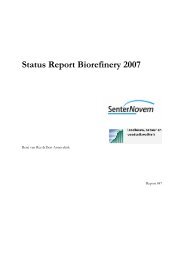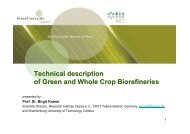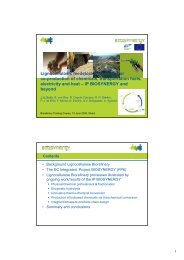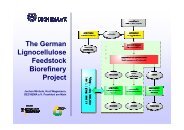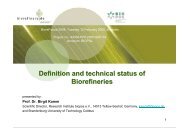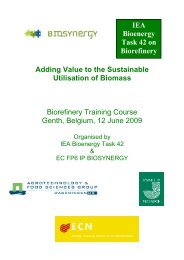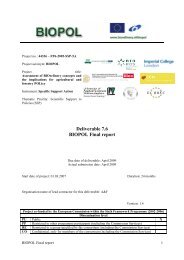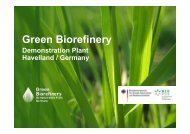D 2.1.1 Note on literature review concerning market ... - Biorefinery
D 2.1.1 Note on literature review concerning market ... - Biorefinery
D 2.1.1 Note on literature review concerning market ... - Biorefinery
Create successful ePaper yourself
Turn your PDF publications into a flip-book with our unique Google optimized e-Paper software.
Biopol - Deliverable <str<strong>on</strong>g>2.1.1</str<strong>on</strong>g><br />
Figure 7: Value chain of the white biotechnology<br />
Agricultural<br />
(by)products<br />
Sugars<br />
Chemical-physical<br />
treatment and/or<br />
enzymes<br />
Cell factory:<br />
Biocatalysis or<br />
Micro-organisms<br />
Biospecialities<br />
Food ingredients<br />
Pharmaceuticals<br />
Fine chemicals<br />
Biomaterials<br />
Base chemicals<br />
Biofuels<br />
Ethanol<br />
Hydrogen<br />
Source: Own illustrati<strong>on</strong> based <strong>on</strong> the European Technology Platform for Sustainable Chemistry<br />
(SusChem) 2007<br />
Searching available <strong>literature</strong> sources biorefinery c<strong>on</strong>cepts were found in U.S. agricultural and forest<br />
products industries, where such facilities produce food, feed, fibre or chemicals, heat and electricity to<br />
run plant operati<strong>on</strong>s. An example is the “Archer Daniels Midland” (ADM) complex in Decatur which<br />
is <strong>on</strong>e of the largest processor of corn, wheat, soybeans and cocoa <strong>on</strong> a global scale. The core product<br />
of the industry is starch and its products. But it is a declared aim to make the producti<strong>on</strong> of starch<br />
more attractive by looking and developing <strong>market</strong>s for co-products of the wet milling process. The<br />
company has a plant in Decatur where industrial enzymes, lactic and citric acid, amino acids as well as<br />
ethanol are produced in a corn wet-milling process. The chemical products, which are produced, are<br />
used in detergents, foods and plastics. The ethanol is used as a transportati<strong>on</strong> fuel or as a solvent. A<br />
further example for a biorefinery c<strong>on</strong>cept is <strong>market</strong> by “Arkenol”. Thereby a variety of bio-based<br />
chemicals and transportati<strong>on</strong> fuels are produced via an acid hydrolysis. A third example is the starchbased<br />
and first large-scale PLA facility of Cargill Dow, which is exploring the use of lignocellulosic<br />
biomass such as corn stove or wheat straw to produce lactic acid, poly-lactid-acid (PLA), ethanol and<br />
other industrial products. It was started up in 2002 with a 300 milli<strong>on</strong> pound capacity (Zwart 2006).<br />
In Europe the following biorefineries (or more precisely plants that follow the biorefinery c<strong>on</strong>cept)<br />
could be identified which are listed in table 4:<br />
Market introducti<strong>on</strong> and development of biorefinery c<strong>on</strong>cepts and related products<br />
Fine chemicals<br />
Bulk chemicals<br />
16



